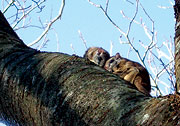
Fly by night: These nocturnal, federally endangered Carolina Northern Flying Squirrels do not actually fly – they glide. photo by J.D. Mays
|
Chris Kelly hardly seems fazed by the frigid wind chill as she makes her way up a narrow, stainless-steel ladder leaned against a yellow birch. Wearing cumbersome yellow gloves, she secures the ladder to the tree with a chain halfway up and then, balancing on the top rung, winds a rope around the trunk to clip onto her waist harness. Finally situated, Kelly gets her net ready and begins the business of knocking on a wooden nesting box that’s wired onto the tree, in hopes that a wild flying squirrel will come scrambling out.
It’s all part of a day’s work for this North Carolina Wildlife Resources Commission biologist, who spends January through mid-March of each year in areas like this ridge in the Great Balsams outside of Canton capturing, weighing, measuring and tagging the federally endangered Carolina northern flying squirrel (Glaucomys sabrinus coloratus) with volunteers in tow. This tiny, tan rodent — not to be confused with the much more common Southern flying squirrel (Glaucomys volans), whose range spans the entire state — is found only in very high-elevation spruce and fir forests in tiny pockets of Western North Carolina, Eastern Tennessee and Southwestern Virginia, where it subsists on a diet of tree lichens and fungi. It was added to the endangered-species list in 1985 in the wake of a major habitat decline brought on by the balsam woolly adelgid — an invasive pest similar the one that’s wreaking havoc on our hemlocks.
There are 15 nesting boxes along this trail, made to mimic the tree cavities the squirrels like to roost in. To locate each one, Kelly has to follow directions like, “Walk 60 paces and turn at the stump next to the rhododendron patch.” The first one is empty, the second has been dismantled by something — possibly a bear — and the third shows signs of a nest but remains uninhabited. On the fourth try, she gets lucky.
Three squirrels are in the box, snuggling together in their nest of shredded birch bark. But after being rudely awakened from their slumber to find themselves dangling in midair in a tubelike red net, they start to pitch a fit. Wouldn’t you? “We try to work as quickly as possible to minimize the stress,” Kelly explains.
Stressful as the temporary capture may be, the monitoring program is important for the squirrels’ survival as a species. Based solely on its severely limited habitat, the Carolina northern flying squirrel may be in dire straits, and it’s only by gathering data that biologists can determine its status and take steps to sustain its population and protect its habitat.
Kelly’s work involves protecting nongame species — that is, all the critters that aren’t hunted for sport — with particular emphasis on those identified as priorities by the state’s wildlife action plan. Funded by a federal initiative called the State Wildlife Grants Program, the action plans aim to protect species before they’re listed as endangered and to monitor the health of those critical habitats and ecosystems that seem to be in decline. Teaming With Wildlife, a national coalition comprising some 4,500 conservation organizations nationwide (including 145 in North Carolina), helps secure the funds from Congress to implement the plans in every state.
Without the federal funding, the flying-squirrel monitoring effort might not exist, says Jeff Schwierjohann, who oversees the commission’s wildlife-diversity programs in the western half of the state. Currently, the federal grants provide 75 percent of the budget; pending budget cuts will require the commission to come up with half of the money. “We’re trying to build up a solid volunteer base” in anticipation of that change, says Schwierjohann, because volunteer hours can be counted as matching funds coming from the state.
And for those who decide to volunteer, it’s a memorable experience. Once Kelly has finished collecting data on the trio of furry highland-dwelling squirrels, she carefully releases them back onto the yellow birch. One by one, they scramble up the tree, find a suitable perch, pause for a moment, then stretch out and take off — sailing gracefully through the air and into the shelter of a rhododendron thicket.



Before you comment
The comments section is here to provide a platform for civil dialogue on the issues we face together as a local community. Xpress is committed to offering this platform for all voices, but when the tone of the discussion gets nasty or strays off topic, we believe many people choose not to participate. Xpress editors are determined to moderate comments to ensure a constructive interchange is maintained. All comments judged not to be in keeping with the spirit of civil discourse will be removed and repeat violators will be banned. See here for our terms of service. Thank you for being part of this effort to promote respectful discussion.